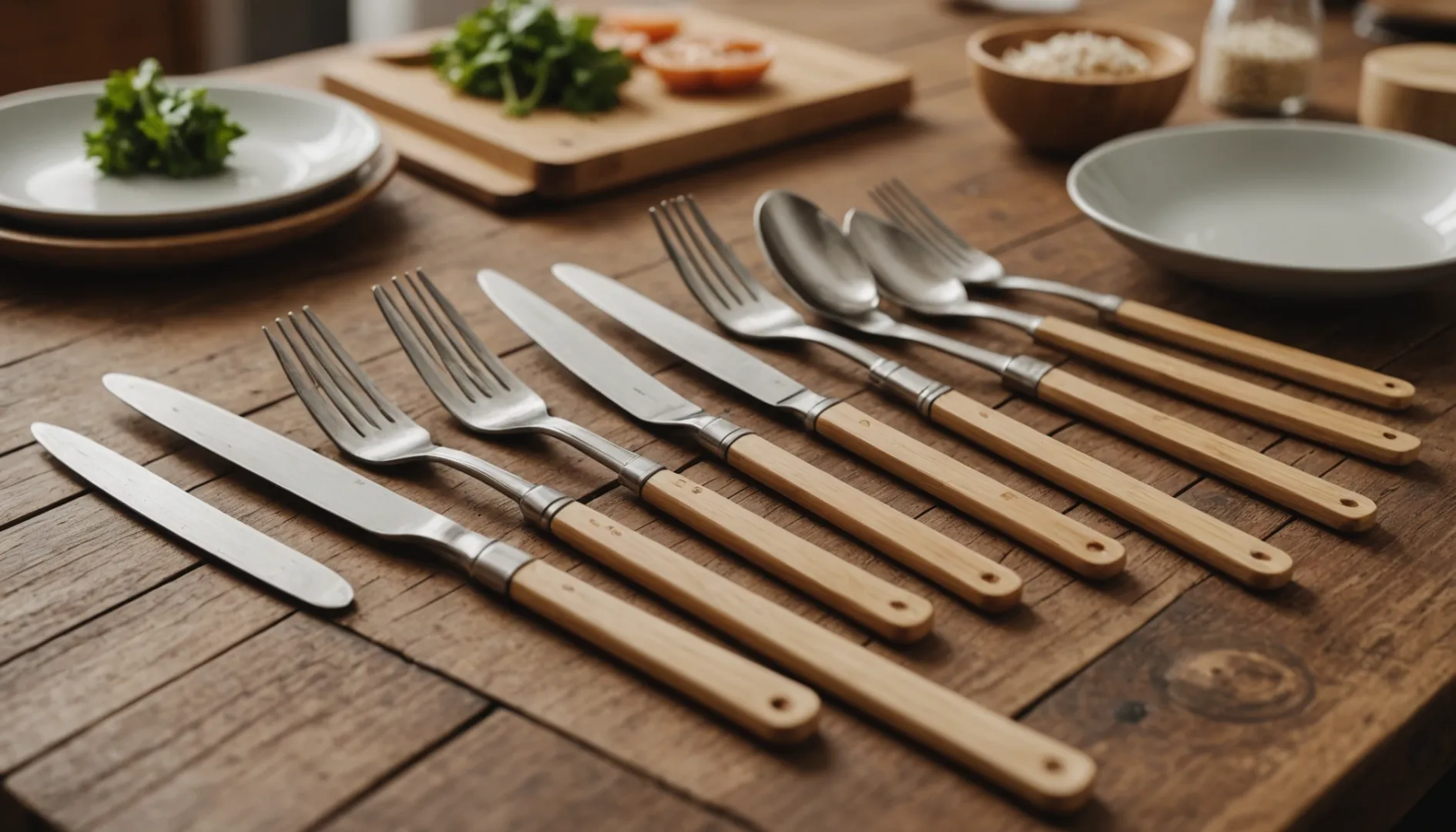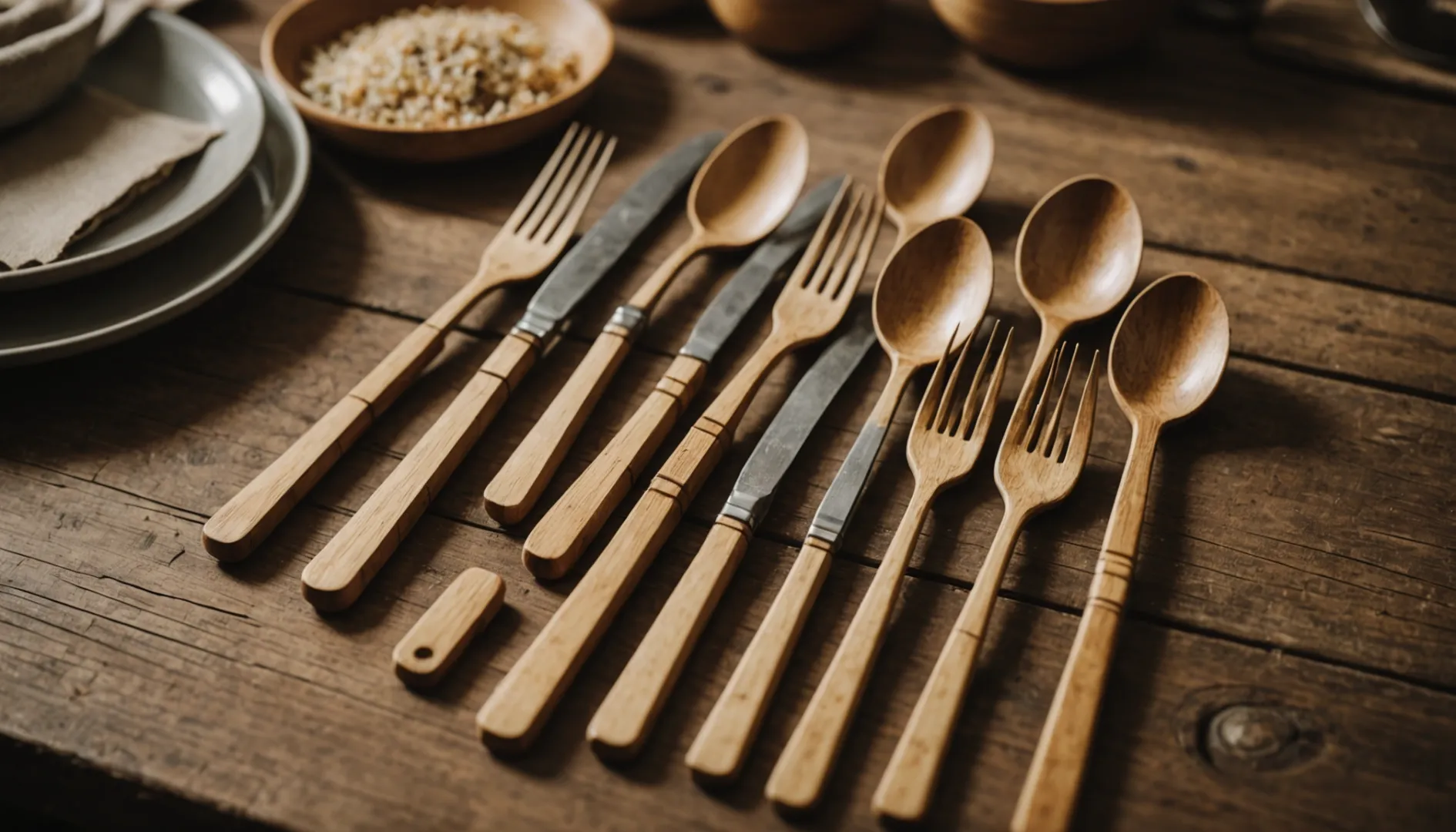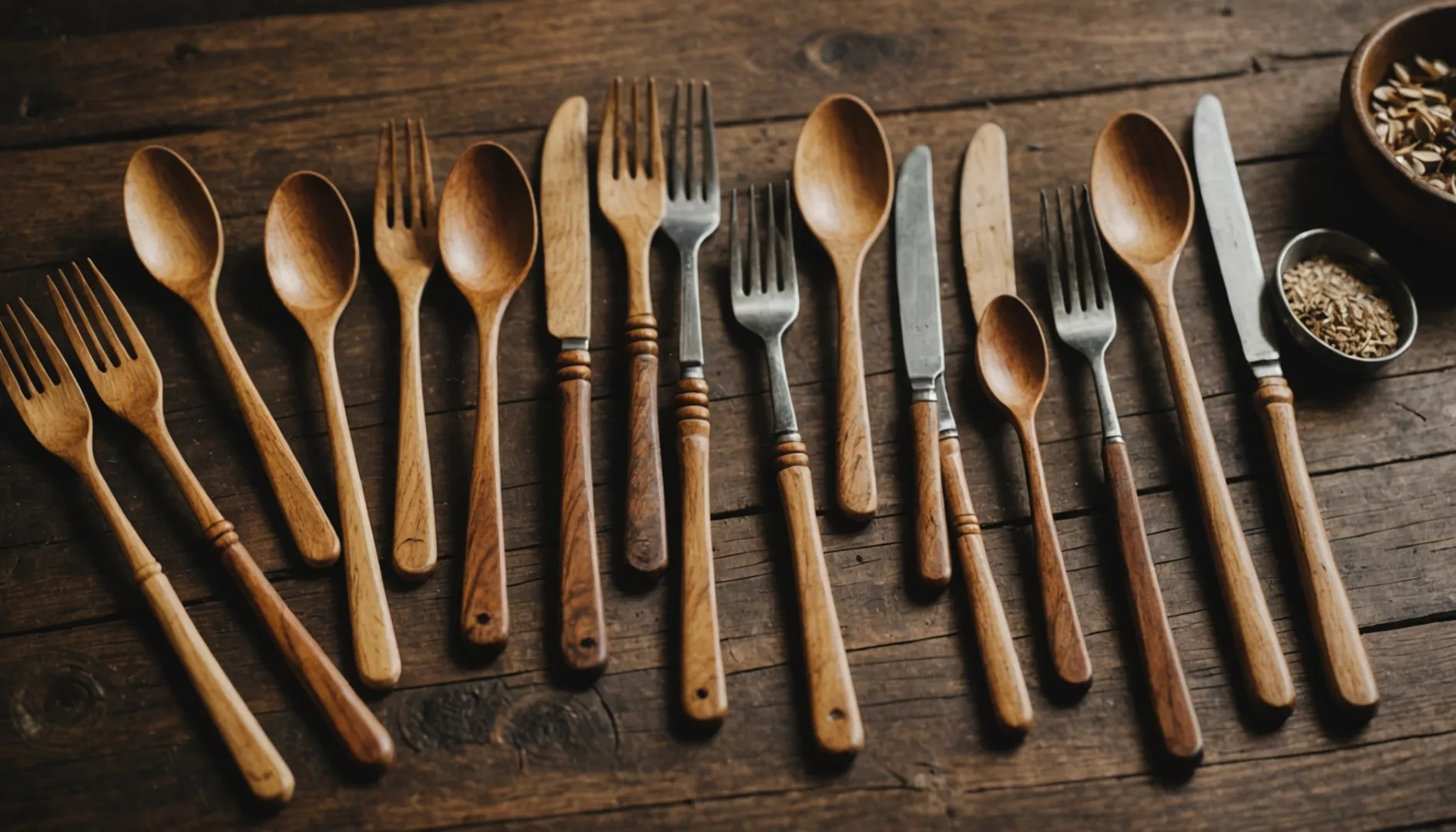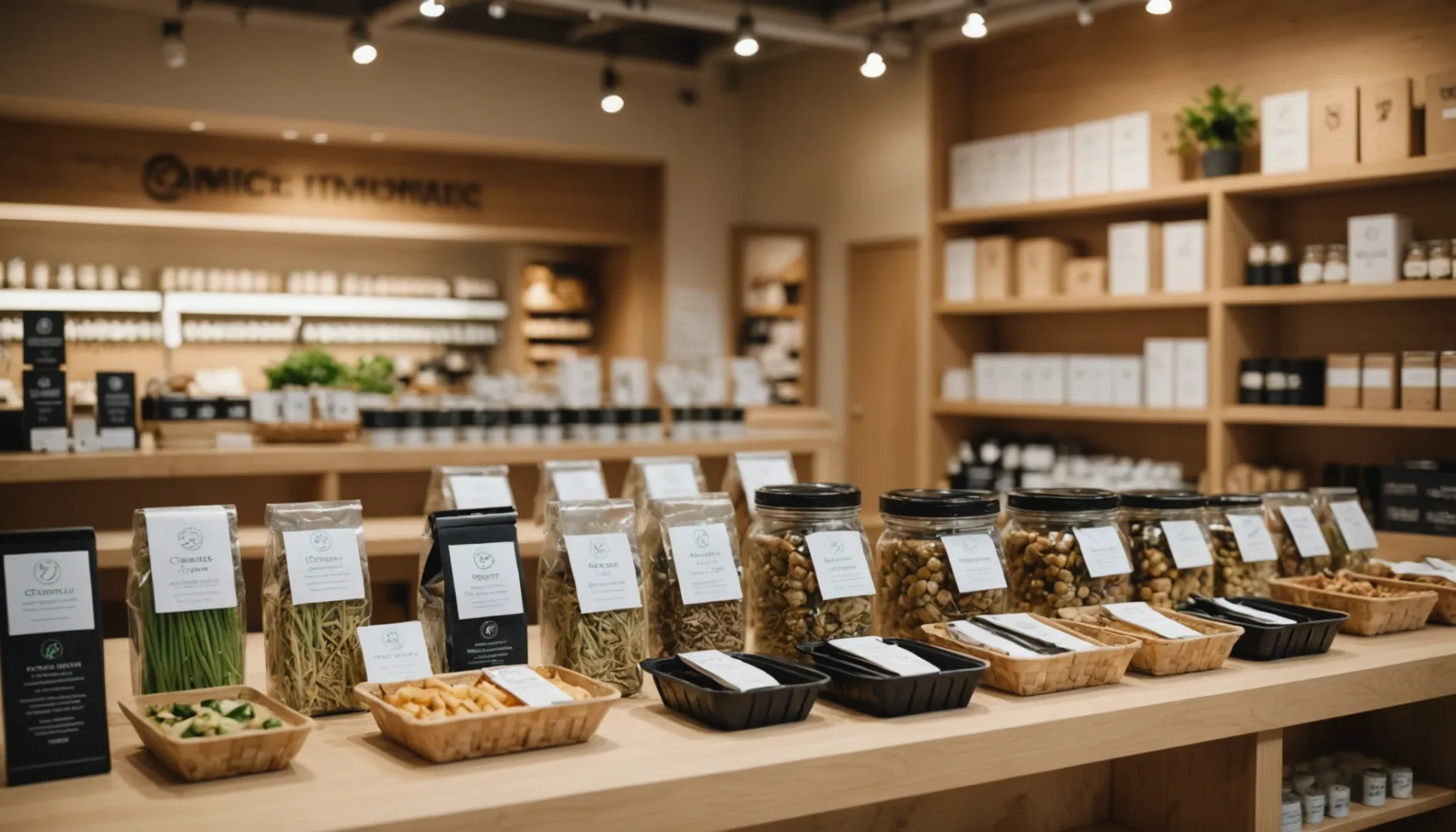
In today’s environmentally conscious world, our choices matter more than ever. The rise of sustainable products is transforming markets globally, and the disposable cutlery market is no exception.
The disposable cutlery market is poised for significant growth due to increasing demand for sustainable alternatives like wooden utensils. Key drivers include environmental regulations and consumer preference for eco-friendly products, with market size expected to expand as innovations enhance durability and usability.
While the initial statistics paint a promising picture of growth, understanding the underlying trends and innovations is crucial for stakeholders. Dive deeper to explore how factors like material choice and eco-certifications are influencing market dynamics.
Wooden cutlery decomposes faster than plastic.True
Wooden cutlery is biodegradable, breaking down in months, unlike plastic.
How Are Environmental Regulations Impacting the Market?
Environmental regulations are reshaping the disposable cutlery market, driving innovation and sustainability.
Environmental regulations are steering the disposable cutlery market towards sustainable materials, reducing reliance on plastic and encouraging innovations like biodegradable coatings. These rules are influencing production processes, supply chains, and consumer choices, fostering a market shift towards eco-friendly alternatives.

The Rise of Eco-Friendly Materials
Environmental regulations are increasingly demanding a shift from traditional plastic to sustainable alternatives in the disposable cutlery market. For instance, many regions have imposed bans or limitations on single-use plastics, spurring a surge in demand for biodegradable materials such as wood and bamboo. This shift is not just regulatory but also consumer-driven, as more people seek products that align with their environmental values. Companies are responding by investing in innovative biodegradable materials1 that meet regulatory standards while appealing to eco-conscious consumers.
Regulatory Push Towards Innovation
As governments tighten restrictions on plastic usage, manufacturers are compelled to innovate. This has led to the development of new materials and coatings that enhance the sustainability of disposable cutlery. For example, some companies are experimenting with compostable coatings that not only meet regulatory demands but also improve product longevity and consumer safety. Such innovations not only comply with current laws but also position companies as leaders in sustainability, potentially offering a competitive edge in a crowded market.
Impact on Supply Chains
Regulations are also affecting supply chains. With the need for certified sustainable sources of wood or bamboo, companies are enhancing their supply chain transparency to ensure compliance. This includes adopting technologies such as blockchain for traceability, which can verify that materials are sourced responsibly. Such measures not only meet regulatory requirements but also build consumer trust by demonstrating commitment to ethical practices.
Consumer Behavior and Market Trends
Environmental regulations have a ripple effect on consumer behavior. As awareness grows about the environmental impact of disposable plastics, consumers are increasingly opting for eco-friendly alternatives. This trend is further bolstered by regulations that limit plastic availability, effectively nudging consumers towards more sustainable options. In response, companies are tailoring their marketing strategies to highlight eco-certifications and sustainable practices, aligning with consumer values and regulatory requirements.
| Regulatory Impact | Market Response |
|---|---|
| Plastic bans | Increase in wooden cutlery production |
| Compostable mandates | Development of innovative coatings |
| Traceability requirements | Adoption of blockchain technology |
Through these changes, environmental regulations are not only shaping the current landscape of the disposable cutlery market but also setting the stage for future innovations and practices.
Plastic cutlery is banned in all regions.False
Not all regions have banned plastic cutlery; regulations vary.
Biodegradable coatings enhance product longevity.True
Innovative coatings improve sustainability and product durability.
What Innovations Are Driving Market Growth?
In the rapidly evolving disposable cutlery market, innovation is key to meeting consumer demands and environmental standards.
Innovations in disposable cutlery focus on enhancing sustainability and usability through material efficiency, eco-certifications, and transparent supply chains. These advancements not only meet regulatory demands but also appeal to eco-conscious consumers, driving market growth.

Innovative Materials and Design
The shift towards sustainable materials is a significant innovation driver in the disposable cutlery market. Traditional plastic utensils are increasingly replaced by wooden cutlery, bamboo composites, and other biodegradable materials. These alternatives are not only environmentally friendly but also designed for durability and functionality.
For instance, some companies are experimenting with compostable coatings that enhance biodegradability while maintaining the product's structural integrity. This innovation ensures that the cutlery can decompose within a few months post-use, significantly reducing environmental impact. Additionally, designs are becoming more minimalist, using less wood without compromising strength, which helps reduce2 both material costs and environmental footprint.
Eco-Certifications and Market Credibility
Eco-certifications play a crucial role in establishing product credibility. Certifications such as FSC (Forest Stewardship Council) ensure that the materials used are sourced sustainably. These certifications are becoming essential as consumers demand more transparency and accountability from brands.
Moreover, Life Cycle Analysis (LCA) provides measurable data on resource usage, allowing companies to demonstrate their commitment to sustainability. Brands that adopt LCA often gain a competitive edge in markets with strict environmental standards. By displaying certifications on packaging, companies can reassure consumers of the product's eco-friendliness, further driving market growth.
Transparent Supply Chains
Transparency in supply chains is becoming a pivotal innovation in response to consumer demand for information on product origins. Technologies like blockchain enable brands to verify and showcase their wood sources, ensuring that materials are harvested sustainably and legally.
This practice not only fosters trust but also aligns with the expectations of eco-conscious consumers. Brands utilizing blockchain can offer verifiable proof of sustainability, setting them apart as leaders in ethical manufacturing. Such transparency encourages consumers to choose products that align with their values, thus stimulating market expansion.
Regulatory Compliance and Market Expansion
As governments in North America and Europe tighten regulations on single-use plastics, compliance with these standards becomes crucial for market growth. Innovations aimed at meeting or exceeding these regulations include designing cutlery for short-term reuse, enhancing durability without sacrificing biodegradability.
In conclusion, the innovations driving market growth in disposable cutlery revolve around sustainable practices, advanced materials, and transparent processes. These factors not only cater to regulatory requirements but also tap into the growing consumer base prioritizing eco-friendly products.
Wooden cutlery is more durable than plastic.True
Wooden cutlery offers durability and functionality, unlike traditional plastics.
Eco-certifications are not essential for market growth.False
Eco-certifications boost product credibility and appeal to consumers.
Why Is Wooden Cutlery Gaining Popularity?
Wooden cutlery is becoming a favorite choice for eco-conscious consumers due to its sustainability and aesthetic appeal.
Wooden cutlery is gaining popularity primarily because it is eco-friendly, biodegradable, and offers a natural aesthetic. Unlike plastic, wooden utensils decompose quickly, reducing environmental impact. Consumers also appreciate the natural feel and look, alongside the health benefits of using non-toxic materials.

The Environmental Appeal
One of the strongest reasons behind the rising popularity of wooden cutlery is its eco-friendliness3. Unlike plastic utensils, which can take centuries to decompose, wooden alternatives break down naturally and quickly. This aligns with growing consumer interest in reducing plastic waste and supporting sustainable products.
Hygienic Advantages
Wooden cutlery is perceived as a safer option compared to plastic due to its non-toxic nature. Many manufacturers apply natural coatings like beeswax or plant oils to enhance durability and resist bacteria. Although these coatings wear off over time, they can be reapplied, making the utensils reusable and maintaining their hygienic quality. This contrasts with the single-use nature of many plastic options that contribute to significant environmental waste.
Design and Aesthetic Preferences
The design aspect of wooden cutlery plays a crucial role in its popularity. Consumers are drawn to its natural look and feel, which can enhance dining experiences. Different woods like maple or oak offer varying textures and colors, catering to both budget-friendly and premium markets. The visual appeal, coupled with the tactile pleasure of using wooden utensils, makes them a preferred choice for many.
| Wood Type | Characteristics | Market Appeal |
|---|---|---|
| Maple | Durable, refined finish | High-end consumers |
| Oak | Strong, resistant to wear | Premium markets |
| Linden | Lightweight, cost-effective | Budget-friendly |
Sustainability Certifications
Certifications such as FSC (Forest Stewardship Council) and eco-labels play a significant role in consumer decision-making. These certifications assure buyers that the wood is sourced sustainably and responsibly. As awareness about environmental issues grows, consumers are increasingly demanding transparency and sustainability in product sourcing.
Impact of Regulatory Changes
With stricter regulations on single-use plastics emerging globally, wooden cutlery offers an attractive alternative that aligns with government policies aimed at reducing environmental impact. These regulations provide a market advantage for wooden cutlery manufacturers, enabling them to capture a larger share of the disposable cutlery market.
Educational Efforts in Consumer Maintenance
Proper care of wooden cutlery can extend its life span significantly. Consumers are being educated on maintenance practices such as regular oiling and avoiding prolonged water exposure. These efforts not only enhance the longevity of the utensils but also promote repeat usage, further bolstering their environmental benefits. Learn how to care for your wooden utensils effectively4.
Wooden cutlery is biodegradable.True
Wooden cutlery decomposes naturally and quickly, unlike plastic.
Plastic cutlery has a natural aesthetic appeal.False
Plastic lacks the natural look and feel that wooden cutlery offers.
How Do Eco-Certifications Influence Consumer Choices?
Eco-certifications are more than labels; they shape consumer behavior and drive market trends.
Eco-certifications influence consumer choices by providing assurance of environmental responsibility and product safety. They act as trusted indicators for eco-conscious consumers seeking sustainable options, thereby boosting demand and brand credibility.

Understanding Eco-Certifications
Eco-certifications are labels awarded to products that meet specific environmental standards. These certifications, such as the Forest Stewardship Council (FSC) and the Programme for the Endorsement of Forest Certification (PEFC), assure consumers that the products have been sourced and manufactured sustainably. In the realm of disposable cutlery5, these certifications are crucial for distinguishing truly eco-friendly options from those that merely claim to be green.
The Role of Trust in Consumer Decisions
Trust is a cornerstone of consumer decision-making, especially when it comes to sustainability. Eco-certifications serve as third-party validations, reducing the ambiguity surrounding environmentally-friendly claims. When consumers see labels like "FSC Certified" on a product, they are more likely to trust its sustainability credentials. This trust translates into purchasing decisions, with consumers often willing to pay a premium for certified products.
Impact on Brand Image and Market Position
Brands that invest in obtaining eco-certifications are often perceived as more responsible and forward-thinking. This perception is particularly important in markets with stringent environmental regulations, such as Europe and North America. Companies that highlight their certifications in marketing strategies can differentiate themselves from competitors and appeal to environmentally conscious consumers.
Consumer Awareness and Education
Educating consumers about the significance of eco-certifications can further influence their choices. When consumers understand what each certification stands for and how it impacts the environment, they are more likely to seek out certified products. This awareness can be fostered through informative campaigns, clear labeling, and transparent supply chains.
A Comparative Look: Certified vs Non-Certified Products
| Feature | Certified Products | Non-Certified Products |
|---|---|---|
| Environmental Impact | Verified low impact | Unverified claims |
| Consumer Trust | High due to third-party validation | Generally lower |
| Market Appeal | Strong in eco-conscious markets | Potentially less appealing |
| Cost | Often higher due to certification process | Typically lower |
Challenges and Opportunities
While eco-certifications provide many benefits, there are challenges associated with their implementation. The certification process can be costly and time-consuming, which might deter smaller companies. However, the long-term benefits, such as enhanced brand loyalty and market differentiation, often outweigh these initial hurdles.
Eco-certifications not only influence individual consumer choices but also drive industry-wide shifts towards sustainability. As awareness grows and regulations tighten, the demand for certified products is expected to increase, creating new opportunities for businesses that prioritize eco-certification.
Eco-certifications boost consumer trust in products.True
Eco-certifications provide third-party validation, enhancing trust.
Non-certified products have higher market appeal than certified ones.False
Certified products appeal more in eco-conscious markets due to verified claims.
Conclusion
The disposable cutlery market is evolving rapidly, driven by sustainability trends and innovative designs. Stakeholders should pay attention to eco-certifications and consumer preferences to seize emerging opportunities in this changing landscape.
-
Explore new eco-friendly materials revolutionizing the cutlery industry.: In this blog post, we will delve into the innovations in biodegradable disposable cutlery materials and discover the eco-friendly revolution. ↩
-
Discover how minimalist design enhances sustainability and cost-efficiency.: Fewer belongings benefit the environment by lowering manufacturing, transportation and packaging emissions for goods and services. The cheaper ... ↩
-
Explore how wooden cutlery helps reduce plastic waste significantly.: The biggest upside of using wood to replace plastic cutlery is that it's a natural, renewable material. This means no fossil-based ingredients ... ↩
-
Discover tips on prolonging the life of your wooden utensils.: Follow these five rules when caring for wooden kitchen utensils: 1. Wash by hand in hot soapy water 2. Always use the scratchy side of your sponge 3. Never put ... ↩
-
Explore different eco-certifications applicable to disposable cutlery products.: 1. BPI. It is the main certification body in North America that focuses on the biodegradability and compostability of disposable tableware products. It also ... ↩

